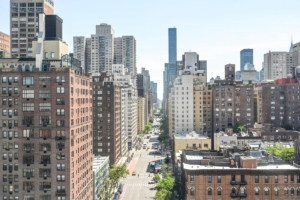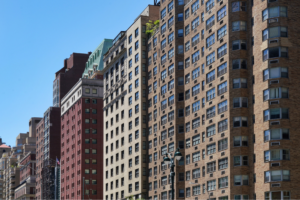A sharp decline in sales inventory in Manhattan and a smaller dip in Brooklyn allowed price growth to accelerate in November. Fewer homeowners put their homes on the market during the highly seasonal slowdown in winter, causing the number of newly listed units in November to also fall sharply. Sales prices subsequently climbed in both boroughs, led by continued momentum in the Upper Manhattan submarket where November’s sharpest decline in inventory was matched with the highest annual growth in median resale price, according to the StreetEasy Price Indices.
Here are more important trends from the Manhattan and Brooklyn markets in November:
Manhattan sales and rental inventory decline
Manhattan sales inventory in November saw a steep 13.3 percent decline from last year, the largest annual decline since February 2013. There was a collective loss of 1,214 units for sale in Manhattan between October and November, which is a monthly decline of 14.3 percent. All told, Manhattan’s total sales inventory fell to just 7,293 units in November, the lowest level on record according to StreetEasy. The Upper Manhattan submarket saw the steepest loss of sales inventory, posting a 33.4 annual decline in November, followed by the Upper East Side submarket (16 percent) and Upper West Side (13.3 percent).
Manhattan rental inventory also declined in November, falling 0.6 percent from last year and marking the first annual rent decline for Manhattan in more than four years. The sharpest rental inventory decline was in the Downtown submarket (8.3 percent), followed by Upper Manhattan (4.1 percent) and the Upper West Side (2.9 percent).
In Brooklyn, total sales inventory declined by 3.2 percent from last year, led by year-over-year losses in the South Brooklyn submarket (6.6 percent) and East Brooklyn (4.5 percent). The loss in inventory was isolated to co-op units, which saw a precipitous 23.4 percent inventory decline from last year. The number of condos and townhouses available for sale in Brooklyn increased by 9.5 percent and 8.2 percent last year, respectively. November rental inventory fell by 4.8 percent from last year and by 12.1 percent from October, the largest monthly decline since November 2011.
[tableau server=”public.tableau.com” workbook=”November2015MarketOverview” view=”inventoryWindow” tabs=”no” toolbar=”no” revert=”” refresh=”yes” linktarget=”” width=”600px” height=”600px”][/tableau]
As the slow winter months advance, more homeowners are waiting for the busier spring season to list their homes. The number of newly listed units for sale in Manhattan plummeted 42.8 percent between October and November in an anticipated and highly seasonal contraction in the sales market. November’s monthly loss of newly listed inventory was slightly worse than in recent years; the five-year historical average monthly decline in November is 33.5 percent.
The number of newly listed units in Brooklyn also saw a precipitous monthly decline in November (40.2 percent), although total volume was still 2.9 percent above last year’s level.
Low inventory allows prices to grow at faster rate
Significant inventory losses put upward pressure on rent and sales prices in November. According to StreetEasy’s Manhattan Price Index, the median resale price in Manhattan rose 6.6 percent from last year to $992,111, the strongest annual growth since January 2015. The median resale price grew the fastest in the Upper Manhattan submarket (19.0 percent), where for 11 consecutive months price growth has been the strongest in Manhattan, followed by Upper West Side (9.5 percent) and Downtown (6.1 percent).
According to the StreetEasy Rent Index, the Manhattan median rent in November grew by 5.4 percent from last year to $3,137, the strongest annual growth since April 2012.
Brooklyn’s median resale price in November rose 11.6 percent from last year to $552,324, according to StreetEasy’s Brooklyn Price Index. The strongest annual price growth was in the East Brooklyn submarket (18.1 percent), followed by Prospect Park (15.5 percent) and Northwest Brooklyn (13.6 percent).
[tableau server=”public.tableau.com” workbook=”priceIndices” view=”StreetEasyPriceIndex” tabs=”no” toolbar=”no” revert=”” refresh=”yes” linktarget=”” width=”600px” height=”750px”][/tableau]
Manhattan sales market slightly more competitive than last year
Key market indicators in November point to a slightly more competitive sales market in Manhattan than last year. Manhattan sellers typically received a larger share of their initial asking price than last year. The median sale-to-list price ratio rose 0.9 points from last year to 99.4 percent, meaning homes typically sold for just 0.6 percent less than the initial asking price in November. Homes were also quicker to sell this November. Homes that sold during the month spent a median of 52 days of the market, three days fewer than last year. Price cuts were also less frequent this November compared to last year. The share of all homes on the market that saw a price cut fell 3.3 points from last year to 31.4 percent last year.
The Upper West Side was among Manhattan’s most competitive neighborhoods in November, where homes that sold in November spent a median of 42 days on the market and sold for 100 percent of the seller’s initial asking price. By those measures, the least competitive Manhattan neighborhood in November was Yorkville, where homes spent a median of 68 days on the market and sold for 3.7 percent less than the initial asking price.
Key market indicators showed mixed results on Brooklyn’s competitiveness relative to last year. Homes that sold in November spent a median time of 47 days on the market, seven days fewer than last year. However, Brooklyn sellers typically received less of their initial asking price than last year. The median sale-to-list price ratio fell 0.3 points to 97.8 percent, meaning homes typically sold for 2.2 percent less than the initial asking price in November. The share of all listings available in November that saw a price cut rose 2.1 points to 27.9 percent.
Among Brooklyn’s most competitive areas in November was the Northwest Brooklyn submarket, which includes Downtown Brooklyn, Brooklyn Heights and Dumbo among others. Homes in that submarket that sold in November typically spent 38 days on the market and sold for 1.8 percent above sellers’ initial asking price. The least competitive area in November was the South Brooklyn submarket, where homes typically spent 56 days on the market and sold for 6.5 percent less than the initial asking price.
Use the chart below to explore the most and least competitive sales markets in Manhattan and Brooklyn. [tableau server=”public.tableau.com” workbook=”November2015MarketOverview” view=”competitiveWindow” tabs=”no” toolbar=”no” revert=”” refresh=”yes” linktarget=”” width=”600px” height=”600px”][/tableau]
Explore all of November’s key market trends in the charts below.
[tableau server=”public.tableau.com” workbook=”November2015MarketOverview” view=”November2015″ tabs=”no” toolbar=”no” revert=”” refresh=”yes” linktarget=”” width=”600px” height=”1050px”][/tableau]









